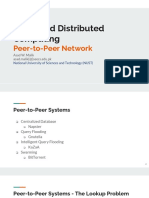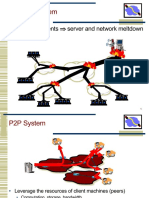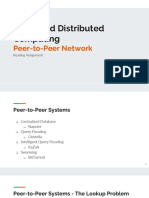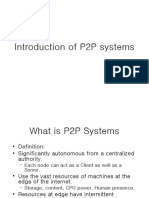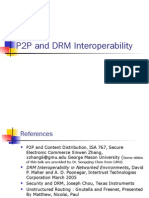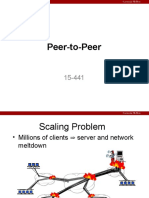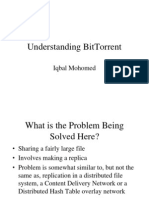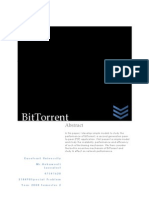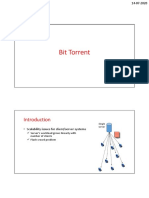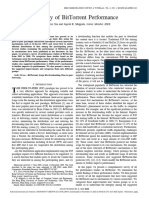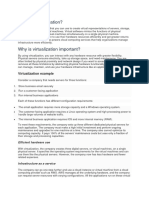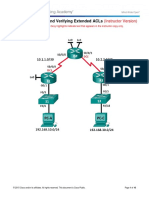ECE 595 Computer Network Systems
Peer-to-Peer Systems
�Applications
File download
Location and Retrieval (Napster, Gnutella) Efficient distribution (BitTorrent, EDonkey)
Audio Conference (Skype) Live Internet Broadcasting
�Scaling Problem
Millions of clients server and network meltdown
�P2P System
Leverage the resources of client machines (peers)
Computation, storage, bandwidth
�P2p file-sharing
Quickly grown in popularity
Dozens or hundreds of file sharing applications 35 million American adults use P2P networks -29% of all Internet users in US! Audio/Video transfer now dominates traffic on the Internet
�Whats out there?
Central Flood Supernode flood KaZaa Route
Search
Napster
Gnutella
DHTs
BitTorrent: Being able to transfer parts of a file at a time
�Searching
N1
Key=title Value=MP3 data Publisher
N2
N3
Internet
? N6
Client Lookup(title)
N4
N5
�Framework
Common Primitives:
Join: how to I begin participating? Publish: how do I advertise my file? Search: how to I find a file? Fetch: how to I retrieve a file?
�Next Topic...
Centralized Database
Napster
Query Flooding
Gnutella
Intelligent Query Flooding
KaZaA
Swarming
BitTorrent
Structured Overlay Routing
Distributed Hash Tables
�Napster: History
1999: Sean Fanning launches Napster Peaked at 1.5 million simultaneous users Jul 2001: Napster shuts down
10
�Napster: Overiew
Centralized Database:
Join: on startup, client contacts central server Publish: reports list of files to central server Search: query the server => return someone that stores the requested file Fetch: get the file directly from peer
11
�Napster: Publish
insert(X, 123.2.21.23) ...
Publish
I have X, Y, and Z! 123.2.21.23
12
�Napster: Search
123.2.0.18
search(A) --> 123.2.0.18 Fetch
Query
Reply
Where is file A?
13
�Napster: Discussion
Pros:
Simple Search scope is O(1)
Cons:
Server may not scale: Server maintains O(N) State Server does all processing Single point of failure
14
�Next Topic...
Centralized Database
Napster
Query Flooding
Gnutella
Intelligent Query Flooding
KaZaA
Swarming
BitTorrent
Structured Overlay Routing
Distributed Hash Tables
15
�Gnutella: History
Released in 2000 Soon many other clients: Bearshare, Morpheus, LimeWire, etc. In 2001, many protocol enhancements including ultrapeers
16
�Gnutella: Overview
Query Flooding:
Join: on startup, client contacts a few other nodes; these become its neighbors Publish: no need Search: ask neighbors, who ask their neighbors, and so on... when/if found, reply to sender.
TTL limits propagation�
Fetch: get the file directly from peer
17
�Gnutella: Search
I have file A. I have file A.
Reply
Query
Where is file A?
18
�Gnutella
Searching by flooding: If you dont have the file you want, query neighbors If they dont have it, they contact their neighbors TTL ensures flooding is controlled Avoid looping: nodes store recent query ids.
No looping but packets may be received twice.
Query response to neighbor requesting query
Forwards it to node it received query from.
19
�Constructing Topology
Node must know one initial bootstrap node. Through query responses, learns about other nodes Can attach itself to some of these. Keeps track of whether neighbor is alive through ping messages.
20
�Gnutella: Discussion
Pros:
Fully de-centralized Search cost distributed Processing @ each node permits powerful search semantics
Cons:
Search scope is O(N) Nodes leave often, network unstable
TTL-limited search works well for popular files
May not work well for files not popular.
21
�KaZaA: History
Created in 2001, by Dutch company Single network called FastTrack used by other clients as well: Morpheus, giFT, etc. Eventually protocol changed so other clients could no longer talk to it Popular file sharing network today
22
�KaZaA: Overview
Smart Query Flooding:
Join: on startup, client contacts a supernode ... may at some point become one itself Publish: send list of files to supernode Search: send query to supernode, supernodes flood query amongst themselves. Fetch: get the file directly from peer(s); can fetch simultaneously from multiple peers
23
�KaZaA: Network Design
Super Nodes
24
�KaZaA: File Insert
insert(X, 123.2.21.23) ...
Publish
I have X! 123.2.21.23
25
�KaZaA: File Search
search(A) --> 123.2.22.50
123.2.22.50 Query Replies
search(A) --> 123.2.0.18
Where is file A?
123.2.0.18
26
�Why Superpeers?
Pros:Query consolidation
Many connected nodes may have only a few files Propagating a query to a sub-node would take more b/w than answering it yourself
Cons: More load on superpeers. Selecting superpeers
How long youve been on is a good predictor of how long youll be around.
27
�KaZaA: Discussion
Pros:
Tries to take into account node heterogeneity:
Bandwidth Host Computational Resources Host Availability (?)
Cons:
Still no real guarantees on search scope or search time
Similar behavior to gnutella, but better.
28
�BitTorrent: History
In 2002, B. Cohen released BitTorrent Key Motivation:
Popularity exhibits temporal locality (Flash Crowds) E.g., Slashdot effect, CNN on 9/11, new movie/game release
Focused on Efficient Fetching, not Searching:
Distribute the same file to all peers Single publisher, multiple downloaders
Has some real publishers
29
�BitTorrent: Distribute chunks at a time
1 2 3 4
3 3 4
Service capacity doubles!
30
�BitTorrent: Overview
A overlay per file Obtain torrent file
File, length, hashing information, url of tracker
Centralized Tracker Server
Join: contact centralized tracker server, get a list of peers. Helps peers keep track of each other
Peer: Seed and leecher
Seed: already obtained full file.
Files broken into segments: segment hash Get segments from peers
31
�Key Ideas
Split the file Form mesh-based overlay Transfer by file blocks
Overlap downloading with uploading (Help each other while downloading) Overlap downloading with downloading Receive the all blocks out-of-order
Key differences from Napster:
Use of chunks instead of entire files Anti-freeloading mechanisms
32
�BitTorrent: Publish/Join
Tracker
33
�BitTorrent: Fetch
34
�BitTorrent: Sharing Strategy
Employ Tit-for-tat sharing strategy
A is downloading from some other people
A will let the fastest N of those download from him
Be optimistic: occasionally let freeloaders download
Otherwise no one would ever start! Also allows you to discover better peers to download from when they reciprocate
35
�Operations
Bootstrap:
New peer P. Contacts tracker. Gets partial list of other peers in the system.
Connection Establishment
Each peer establishes connections with other peers Peers exchange bitmaps reporting which pieces they have Updated as and when new pieces downloaded.
36
�Maintaining block diversity
Diversity
1 2 3 4
No Diversity
1 2 3 4
1 3 3 4 4
1 ??
??
Distributed coordination: To select block to download: Rarest block first
37
�Guard against free-riding
Free-riding: (Selfish, harmful to system)
downloading without uploading
Solution: Tit-for-tat:
If you dont upload to me, Im not uploading to you! Free-rider is punished How much you give is how much you get
38
�BitTorrent: Summary
Pros:
Works reasonably well in practice Gives peers incentive to share resources; avoids freeloaders
Cons:
Central tracker server needed to bootstrap swarm Not clear how effective tit-for-tat is.
39
�Next Topic...
Centralized Database
Napster
Query Flooding
Gnutella
Intelligent Query Flooding
KaZaA
Swarming
BitTorrent
Unstructured Overlay Routing
Freenet
Structured Overlay Routing
Distributed Hash Tables (DHT)
40
�Distributed Hash Tables (DHTs)
Gnutella: flooding oriented search
Expensive for items not as popular.
DHTs
Developed in academic community Ensures efficient search/lookup without flooding Makes some things harder
Fuzzy queries / full-text search / etc.
Deployment
Adopted by recent versions of BitTorrent, and Emule (Kad)
41
�Distributed Hash Tables
Nodes in system form a distributed data structure
Clever structure Convenient to locate objects Different than Gnutella: structure can be arbitrary
Each node has a unique id.
Usually hash of nodes IP address
Each object has a unique id.
Usually hash of filename. Map object to node nearest it in id space
42
�DHT: Overview
Structured Overlay Routing:
Join: On startup, contact a bootstrap node and integrate yourself into the distributed data structure; get a node id Publish: Route publication for file id toward a close node id along the data structure Search: Route a query for file id toward a close node id. Data structure guarantees that query will meet the publication. Fetch: Two options:
Publication contains actual file => fetch from where query stops Publication says I have file X => query tells you 128.2.1.3 has X, use IP routing to get X from 128.2.1.3
43
�Structured Networks
Distributed Hash Tables (DHTs) Hash table interface: put(key,item), get(key) O(log n) hops
K I
(K1,I1)
K I
K I K I
I1
K I
K I
K I
put(K1,I1)
K I K I
get (K1)




